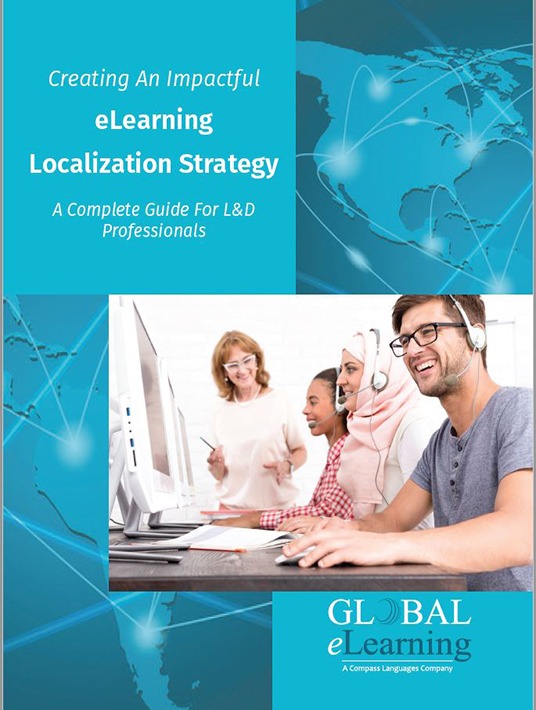Give Meaning To Your Content By Creating An Impactful eLearning Localization Strategy
This eBook provides a fundamental insight into how you can implement an impactful eLearning localization strategy. It speaks for itself that a company would love to have employees feel empowered and engaged. All whilst knowing this is an enormous boost for ROI; the indirect consequences of properly implemented localization strategy. Localizing content is the task of transforming information from one language (source) into another language (target) in a way that the end-user will digest with maximum comprehension. The word "translation" is often misused instead of localization.

While these terms sound similar, there is a significant difference in the details, especially when cultural elements are involved. So, then the question remains, as with any process. How do we execute this strategy? This eBook offers great insight into the value of localizing eLearning content for a global workforce. Above all, it hands you the strategies to do so.
About This eBook: What Localization Really Is
If localizing eLearning content is the task of transforming information from one language (source) into another language (target), this more or less sounds like translation, right? Well, not close enough. There is a clear distinction to be made. Before we proceed we need to clarify what the distinction is, as is defined by the authors in this eBook:
- Localization
It refers to the adaptation of a product, application or document to meet the linguistic, cultural and other requirements of a specific target market. - Globalization (Or Internationalization)
It is the design and development of a product, application or document content that enables easy localization for target audiences that vary in culture, region, or language. - Translation
It is a subset of localization where the service is only concerned with finding a word for word (textual) comparison between one language and another.
Once we all know the difference and can eloquently describe what it is that distinguishes the three aforementioned categories, the time has come to refine the different methods of implementation.
Scaling A Localization Strategy
In the eBook, they proceed to emphasize why there are definite benefits to a centralized strategy as opposed to a decentralized one. Then, they continue to include factors that drive cost and schedule in the localization of eLearning content.
Explaining how most corporations take great care in developing eLearning content for training purposes.
"Manufacturing processes, pharmaceutical sales strategies, and the administration of health care - to name just a few - require diligence to ensure that the overall message and intention of the training is accurate, compliant and effective. When it becomes necessary to translate and localize that content for a global audience, many companies struggle with the effectiveness, costs, and scheduling aspects of the localization process. In this article, we discuss the factors and complexities that drive localization costs and schedules and how you can manage them effectively."
They advance to speak about the biggest problem companies face when it comes to localization, and how transparency pays off in the long run. A profound truth that should be exposed very early in the process: the integrity of the source content and its relevance to the target audience.
This eBook contains tons of information concerning all the different variables which help influence your localization strategy in a positive way. First by understanding, later by implementing.
It is through localization that we can fully transfer knowledge from one language/culture into another, in such a manner that this knowledge is grasped, adopted, and implemented. When performed successfully, the return on investment is demonstrated through any combination of results, as defined by the authors in this eBook:
- An increase in revenue
- Lost/injury time reduction
- Higher productivity
- Higher retention
- A more compliant, engaged workforce
Global eLearning’s expertise can be compiled into their ‘5 Global Training Rules' which they believe any successful global training initiative should adhere to:
- People want to learn in their native language.
- Learners respond positively, even dramatically, to localized content.
- A scalable localization strategy is built upon a process that produces a reliable,“on-time” quality product consistently.
- The greater the scope of languages, the more disciplined a company must be in controlling original content design.
- Engagement is achieved by knowing the target audience's perspectives, culture, and learning patterns.
We need a full understanding of culture and learning preferences before we embark on the task of localizing specific eLearning content. Important decisions are to be made on an educational level after we have understood ourselves how a specific group of people, from a specific location, learns, always taking into account that cultures, language, and content are nuanced. Chances are that most likely there is something we, as content facilitators, are missing. At the basics, embracing common learning patterns and characteristics, and simultaneously letting go of deeply held beliefs, whilst at the same time realizing that your participants might just have their own.
Learn And Let Others Learn
Any content within the eLearning Industry should always be adapted to a specific language, culture or market to avoid any type of cross-cultural misunderstandings. Enhancing a participant's ability to feel engaged and quite literally help them understand the content better. At all times, making sure that small cultural nuances are adhered to. No 'wannabe' native attempts but true translations, safeguarding key elements of the content takeaways. It's an extensive process to incorporate all the necessary tools to make some localization magic happen. Download our eBook Creating An Impactful eLearning Localization Strategy: A Complete Guide For L&D Professionals to discover how a great eLearning localization strategy can help you turn your employees into rising stars and unlock their true potential. It also features tips to go global by launching an engaging program for your multicultural workforce.







